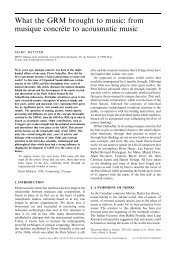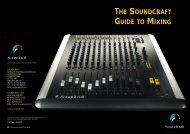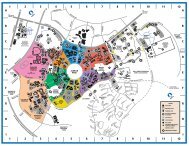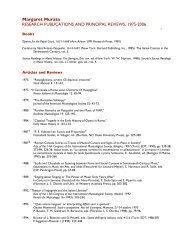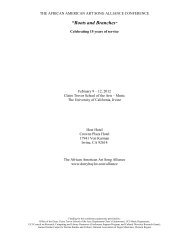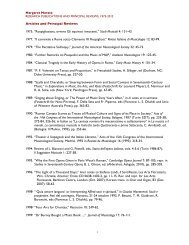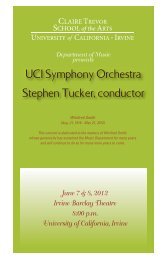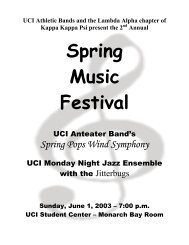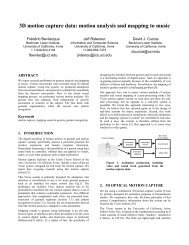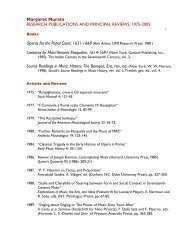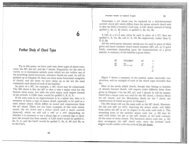amy bauer The Other of the Exotic: Balinese Music as Grammatical ...
amy bauer The Other of the Exotic: Balinese Music as Grammatical ...
amy bauer The Other of the Exotic: Balinese Music as Grammatical ...
Create successful ePaper yourself
Turn your PDF publications into a flip-book with our unique Google optimized e-Paper software.
<strong>The</strong> <strong>O<strong>the</strong>r</strong> <strong>of</strong> <strong>the</strong> <strong>Exotic</strong> 357<br />
representation <strong>of</strong> <strong>the</strong> core melodic structure in Section 1 <strong>of</strong> ‘Galamb borong’<br />
(Ex. 13) reveals a tight contrapuntal structure that is not evident on <strong>the</strong> surface<br />
<strong>of</strong> <strong>the</strong> piece. My analysis identifies six b<strong>as</strong>ic motives which recur throughout <strong>the</strong><br />
Étude, each with a particular function defined by its position and number <strong>of</strong><br />
reiterations in <strong>the</strong> core melodic voice <strong>of</strong> both hands.<br />
<strong>The</strong> series B4–E♭5–G5–D♭5, each pitch <strong>of</strong> which falls on successive downbeats<br />
<strong>of</strong> <strong>the</strong> opening cycle, establishes <strong>the</strong> main <strong>the</strong>me (MT), or subject, <strong>as</strong> a<br />
motto featuring rising intervals <strong>of</strong> a major third (interval cl<strong>as</strong>s 4) in one direction,<br />
followed by a falling tritone. This <strong>the</strong>me fragments immediately, recurring<br />
<strong>as</strong> a three-note head (B5–E♭6–G6 and F6–A6–D♭7, bars 25–26) or tail motive<br />
(C3–E3–B♭2, bar 25). A neighbour figure (N) follows <strong>the</strong> first appearance <strong>of</strong><br />
<strong>the</strong> <strong>the</strong>me proper; this oscillation <strong>of</strong> major seconds functions <strong>as</strong> a means <strong>of</strong><br />
retarding <strong>the</strong> transition from one registral level to ano<strong>the</strong>r (D5–E5, bars<br />
12–13; G♭5–A♭5, bars 13–14; E♭5–F5, bars 18–20; and E♭6–D♭6, bars 23–24). A<br />
three-note descending scale in bar 9 (a marker <strong>of</strong> <strong>the</strong> second level <strong>of</strong> intensity<br />
in Ex. 12) acts <strong>as</strong> a countersubject (CS) to <strong>the</strong> main <strong>the</strong>me; <strong>the</strong> countersubject<br />
returns prominently, expanded and inverted, throughout <strong>the</strong> Étude, appearing<br />
with greatest intensity in <strong>the</strong> sixth octave at <strong>the</strong> climax <strong>of</strong> <strong>the</strong> work (bar 72).<br />
A second <strong>the</strong>me (ST) appears in <strong>the</strong> right hand in bars 11–12: a repeated G6<br />
followed by a whole tone up and tritone down which inverts <strong>the</strong> tail <strong>of</strong> <strong>the</strong> main<br />
<strong>the</strong>me.<strong>The</strong> second <strong>the</strong>me first appears alongside a reduced version <strong>of</strong> itself in <strong>the</strong><br />
left hand (marked STs: B♭4–C5–A♭4); it is followed by a shift to A6 against three<br />
versions <strong>of</strong> itself, a four-voice chorus which announces <strong>the</strong> first large-scale<br />
elongation <strong>of</strong> <strong>the</strong> rhythmic pattern (bars 15–17). <strong>The</strong> second <strong>the</strong>me instigates<br />
development in Section 1, moving from <strong>the</strong> b<strong>as</strong>s voice to <strong>the</strong> upper voice at<br />
<strong>the</strong> end <strong>of</strong> <strong>the</strong> section (bars 27–28). <strong>The</strong> tritone found in both <strong>the</strong> main and <strong>the</strong><br />
second <strong>the</strong>mes is preceded by a whole tone in <strong>the</strong> same direction to form <strong>the</strong><br />
transition motive (TR), which appears three times <strong>as</strong> a means <strong>of</strong> progressively<br />
expanding <strong>the</strong> Étude’s registral comp<strong>as</strong>s (C4–B♭2–E2, bar 7; F6–G6–D♭7, bars<br />
10–11; and E2–D2–A♭1, bar 26). <strong>The</strong> final <strong>the</strong>matic motive, labelled ‘wedge’<br />
(W), first appears <strong>as</strong> <strong>the</strong> second half <strong>of</strong> <strong>the</strong> countersubject in <strong>the</strong> b<strong>as</strong>s (G♭4–E4–<br />
C4–B♭3–C4); <strong>the</strong> falling whole tone–major third–whole tone turn appears only in<br />
descent in <strong>the</strong> left hand, and only in <strong>as</strong>cending form (inversion) in <strong>the</strong> right.<strong>The</strong><br />
wedge motive moves outwards in both directions, appearing twice in its full<br />
version before fragmenting to close out <strong>the</strong> section in both hands (F7–A7–B7,<br />
right hand, bars 8–29; and C6–B♭5–G♭5–E5, and so on, left hand, bars 28–32).<br />
I have chosen to identify <strong>the</strong> head note <strong>of</strong> each motive with <strong>the</strong> corresponding<br />
‘scale degree’ belonging to each mode. Taking <strong>the</strong> opening tremolo <strong>as</strong> a cue, I<br />
begin <strong>the</strong> ‘even’ whole-tone scale (modal scale degrees ˆ2, ˆ4 and so on) on A♭ and<br />
<strong>the</strong> ‘odd’ (modal scale degrees ˆ1, ˆ3 and so on) on F. Working with modal scale<br />
degrees (ra<strong>the</strong>r than pitch or pitch-cl<strong>as</strong>s notation) allows one more e<strong>as</strong>ily to track<br />
contrapuntal lines and <strong>the</strong>ir correspondence between hands through each <strong>of</strong> <strong>the</strong><br />
constituent voices <strong>as</strong> <strong>the</strong>y depart from and return to <strong>the</strong> normative minor-third<br />
relation between <strong>the</strong> hands established at <strong>the</strong> work’s outset. 31 Despite <strong>the</strong> homo-<br />
<strong>Music</strong> Analysis, 27/ii-iii (2008)<br />
© 2009 <strong>The</strong> Author.<br />
Journal compilation © 2009 Blackwell Publishing Ltd.



